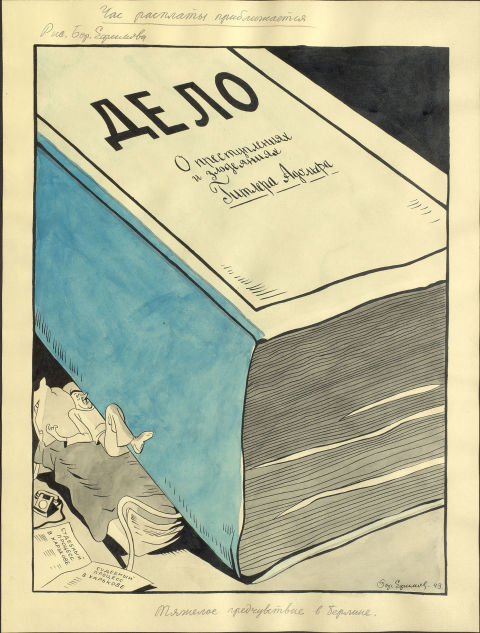“Why write then?” someone might say. “What is the use of recalling all this?” It is the duty of the writer to tell the truth however grueling, and the duty of the reader to learn the truth. To turn aside, or to close one’s eyes to the truth is to insult the memory of the dead.
Vassily Grossman
The Treblinka Hell, 1944, used by the prosecution
as evidence during the Nuremberg trials.
Hello,
Welcome to the website of Nuremberg: Casus Pacis, an international transmedia educational and awareness project.
We, its authors, designed this project as a cultural, educational and awareness-building initiative telling the story of the Nuremberg trials, the most important trials in the history of humanity.
The Nuremberg trials shaped today’s political order, and its verdicts inspired post-war humanism in both theory and practice. These trials were a way to name and do away with a political, social and military evil, and a testimony to inescapable justice signaling the return to civilization, no matter how far the destruction of the very foundations of existence had gone.
Nuremberg trials were more than just court proceedings. It was an institution that shaped today’s international law. The Charter of the International Military Tribunal and its verdicts lie at the core of the modern legal system. It was then that the principle took shape according to which the fact that a person acted pursuant to an order does not relieve him from responsibility, alongside the principle of equality before the law, including for heads of state, politicians, senior government officials and the military.
This was not a trial against Germany, or an act of reprisal by the victors over the vanquished. These trials sought to safeguard humanism and defend people. Nuremberg sided with the victims.
It was in Nuremberg that the term genocide was introduced. Before the tribunal, war crimes went unpunished. Nuremberg introduced responsibility for war crimes and wars of aggression. It revealed the scale of the genocide and showed the overall picture of Nazi efforts to exterminate peoples around the world.
The criminals did not repent. Only by uniting their forces did the Allies force the evil to retreat.
People from across the world came together to hold these trials. Nuremberg was the first major legal act adopted by the United Nations. These trials can be described as countries of the world vs. evil.
We strongly believe in the need to tell new generations, who often ignore the true history of World War II, about its exploits, suffering and crimes. The phrase about “saving the world from the brown plague” is not an exaggeration, not a slogan or a propaganda cliché. It is the reality that remains relevant to this day. The world we live in today is shaped by the saved lives, our lives.
Knowing the history of World War II, and Nuremberg is definitely one of its key takeaways, is essential for understanding today’s world, the post-war period and international relations. We need to preserve this knowledge and pass it on to future generations. This is what this website and project are all about.
The trials have a captivating, dramatic history. It is a story of courage and villainy, imminent punishment and the human aspiration to justice. We will tell this story day by day.
The purpose of this project is to accurately recreate the emotions, facts and evidence pertaining to this period.
The project is based on first-hand accounts and documentary evidence. We worked in the main Russian and foreign archives to uncover Nuremberg’s heritage.
The brilliant masters of journalism with their traditions and experiences guided our efforts. The best Russian and Soviet writers, artists and reporters sought to frame this turning point in the history of the 20th century in their works.
Nuremberg. Casus pacis is a project of a new media age. It incorporates the latest technology and media narratives. Nuremberg: Casus Pacis includes exhibitions, VR reenactments, podcasts, public talks, performances and conferences. We create multimedia and transmedia narratives across various platforms and genres to reach the broadest possible audience. Our aim is to encourage you to explore and discuss documentary evidence and academic papers, invite you to history talks and battles on various platforms and mediasystems.
Our project targets the Russian, as well as Western audiences. We want to launch a conversation in Russia, the United States and in Europe on what brought us together in Nuremberg, divided us after the Fulton speech and what could bring us together again.
This educational project exists in four languages: Russian, English, French and German.
It was created by Rossiya Segodnya media group, Sputnik news agency and a group of investigative journalists.
The project involved the Russian State Library, Gosfilmofond state film archive, the Museum of Contemporary History of Russia, the Victory Museum, the Multimedia Art Museum, the Central Armed Forces Museum of the Russian Federation, the Gorky Moscow Art Theater, the State Archive of the Russian Federation, the Russian State Archive of Phonodocuments, the Russian State Archive of Social and Political History, the Central Archive of the Federal Security Service and the Federal Archival Agency.
The project’s media partners are Rossiya 24 television network, Komsomolskaya Pravda publishing house, Moskva 24 television channel, Radio Rossii and Vesti FM radio stations, Vesti.Ru, Mayak radio station, TVzavr online streaming services, the State Historical Museum and the Jewish Museum and Tolerance Center.
The project will be presented on a dedicate page – nuremberg.media, and on social media.
It will run from November 2020 until October 2021, following the proceedings that lasted from November 20, 1945 until October 1, 1946.
It will end in 2021 in Nuremberg.
























